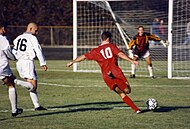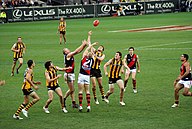Boolu-afesegba
Bọ́ọ̀lù-àfẹsègbá jẹ́ ọ̀kan lára àwọn eré-ìdárayá tó ní ṣe pèlú fífi ẹsẹ̀ gbá bọ́ọ̀lù. Eré-ìdáraya h yìí pẹ̀ka sóríṣiríṣi ọ̀nà, ara rẹ̀ la ti rí association football, gridiron football tàbí American football tàbí Canadian football, Australian rules football, rugby union pẹ̀lú rugby league àti Gaelic football.[1] Oríṣi ẹ̀ka bọ́ọ̀lù-àfẹsẹ̀gbá wọ̀nyí ní nǹkan tó pa wọ́n pọ̀, tí a mọ̀ sí kóòdù bọ́ọ̀lù-àfẹsẹ̀gbá[2]
 An attacking player (No. 10) attempts to kick the ball past the goalkeeper and between the goalposts to score a goal | |
| Highest governing body | FIFA |
|---|---|
| Nickname(s) | Football, soccer, futbol, footy/footie, "the beautiful game" |
| First played | Mid-19th century England |
| Characteristics | |
| Contact | Yes |
| Team members | 11 per side |
| Mixed gender | Yes, separate competitions |
| Categorization | Team sport, ball sport |
| Equipment | Football |
| Venue | Football pitch |
| Olympic | 1900 |
Oríṣiríṣi ìtọ́kasí ló wà fún bọ́ọ̀lù ìbílẹ̀ tí wọ́n ń gbá káàkiri àgbááyé.[3][4][5] Ó sì ní òfin tó de wọ̀n, àwọn òfin yìí ti wà láti sẹ́ńtúrì kọkàndínlógún.[6][7] Ìtànkálẹ̀ British Empire mú kí àwọn òfin yìí tàn káàkiri eré náà.[8] [9]
Ní ọdún 1888, wọ́n ṣe ìdásílẹ̀ The Football League ní England, èyí sì jẹ́ ẹgbẹ́ bọ́ọ̀lù-àfẹsẹ̀gbá alámọ̀dájú àkọ́kọ́. Ní sẹ́ńtúrì ogún, ọ̀pọ̀lọpọ̀ bọ́ọ̀lù àfẹsẹ̀gbá lọ́ríṣiríṣi wá di ìlú-mọ̀ọ̀nká, tí wọ́n sì ń gbá káàkiri orílẹ̀-èdè ní àgbááyé.[10]





